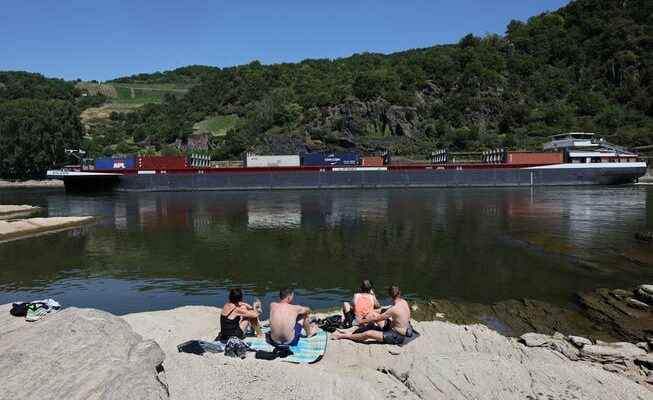Cargo ship traffic on the Rhine could largely come to a standstill in just a few days. Even now, the ships can only be loaded with a significantly lower capacity.
Even in the current dry phase, the water level near Kaub, not far from the Loreley, is the measure of all things.
For shipping, the section below the notorious Loreley rock in the German state of Rhineland-Palatinate is still one of the most dangerous places on the Rhine. Whether high or low water – nowhere is the risk of running aground so great. Even in the current dry phase, the water level near Kaub, not far from the Loreley, is therefore the measure of all things. The last time the water level was above one meter was in mid-July. On Thursday it was only 55 centimeters. He is rapidly approaching the 40 centimeter mark. Below that, shipping with large quantities of goods is practically no longer possible.
If the current forecasts are correct, it should be ready by the end of next week. However, a noticeable decline in shipping traffic can already be observed at the Basel Rhine ports (Port of Switzerland). Port of Switzerland does not have detailed figures, but industry experts estimate that the current transport capacities are less than a quarter of the normal level.
Only a fraction of the loading capacity
It’s not just the number of boats that’s constantly declining. The cargo ships can also be loaded less because of the low water level. Ships that can usually transport 3000 tons are currently perhaps still on the road with 900 to 1000 tons, estimates André Auderset, Managing Director of the Swiss Association for Shipping and Port Industry (SVS).
The Federal Office for National Economic Supply (BWL) assumes that ships will soon only operate with an immersion depth – the so-called unloading – of 16 percent. Calculating the transport capacity is complex because, apart from the water levels, it depends on various other factors – for example the type of ship, the experience of the crew and the weather forecast.
The level at Kaub is already lower than it has been for four years. However, the situation on the Rhine is not yet as dramatic as it was in 2018. Back then, it was so dry for several weeks in late summer that shipping was severely restricted until October. At times, large-scale shipping near Basel was even completely suspended. In contrast to high water, there is no specific point at which shipping stops when water levels are low, as Jelena Dobric from Port of Switzerland explains.
The fact that the situation is already extremely tense also has to do with the war in Ukraine. In Germany in particular, large capacities are currently required for the transport of coal, as Auderset explains. In some cases, ships have also been diverted to the Danube because they are needed there for transporting grain. Rail is also currently being used to capacity and is only a limited alternative to waterways. This is observed by Fabian Bilger, deputy managing director of the industry association Avenergy Suisse.
According to the federal government, the situation is “very tense”
The Rhine ports are of great importance for the import of mineral oil. Around a third of the demand is imported via Basel by ship. The transport capacity is severely limited for his industry, explains Bilger. It makes things a little easier that not all petroleum products have to pass through Kaub, as some of the combustibles and fuels destined for Switzerland are first loaded in Ludwigshafen.
In a situation assessment on Thursday, the BWL described the supply situation for heating oil as currently “secured, but very tense”: the situation in cross-border traffic has worsened compared to the previous week. Two weeks ago, the BWL had decided to fall short of the mandatory stockpile of heating oil by 6.5 percent by the beginning of September. However, no additional measures are currently necessary. According to the BWL, dry shipping is also fully utilized and there are bottlenecks both in the availability of cargo space and at the terminals.
The tense situation is already making itself felt in prices. Transporting a tonne of goods to Basel normally costs between 20 and 30 francs, but by mid-July the price had risen to around 70 francs. According to industry experts, it was already CHF 180 at the beginning of this week. Due to the high price of oil, however, demand is not particularly high despite the looming energy crisis – on the contrary: private customers are cautious.
However, the major water shortage in 2018 showed the strain that a prolonged dry period can have on shipping and the port industry. At the time, Auderset spoke of a “catastrophic situation”. It is therefore crucial how the water level develops in the coming weeks: “We are currently only at the beginning,” says Auderset. This time, the drought will also be a particular burden for passenger shipping. After two years of Corona, this summer is particularly dependent on business.
Shipping channels are deepened
Due to climate change, phases with low water levels will become more frequent in the future. Rhine navigation must therefore adapt regardless of the special situation this year. For example, by using lighter ships that have less draft. The routes will also be adjusted. In Basel, for example, the shipping channel was deepened by 30 percent three years ago. There is a similar project for the particularly delicate section near Kaub. But how many dry summers will still pass before the plans are implemented is an open question.
